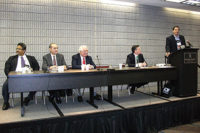This, in turn, could expand the market for designers and technicians skilled with ice-making systems in the future.
In one case, a University of Missouri-Rolla professor is pondering using ice instead of plastics as part of the manufacturing process.
Dr. Ming Leu is experimenting with a new means of rapid prototyping — a process designed to quickly and inexpensively make models of parts or products. He calls the use of ice rather than plastics “rapid-freeze prototyping,” or RFP.
New Use for Ice
“Compared with other prototyping methods, it’s cheaper, faster, and much cleaner,” said Leu, who is in the college’s Department of Mechanical & Aerospace Engineering, and Engineering Mechanics. “But it’s also very challenging because you must have a controlled environment for the process.”Manufacturers have been using rapid prototyping technologies since the mid-1980s. In its more traditional form, rapid prototyping (sometimes called “desktop manufacturing”) involves the fabrication of three-dimensional models, layer by layer, directly from 3-D computer drawings with a computer-controlled machine. These prototypes typically are made from a polymer resin.
Leu contends that rapid-freeze prototyping would not only be faster, reducing the time to produce a prototype from days to a matter of hours, but also cleaner. And because water is cheaper than plastic polymers, the process would be less expensive.
RFP works in a fashion similar to other rapid prototyping techniques.
In his Virtual and Rapid Prototyping Laboratory in the college’s Engineering Research Laboratory, Leu built an experimental system through which droplets of water are deposited from a nozzle onto a surface within a freezing chamber. Leu’s system first creates a frozen “shell,” or boundary, out of ice, then fills the enclosed interior with a steady stream of water that freezes.
Although his system is still experimental, Leu believes it offers manufacturers a variety of advantages to traditional prototyping systems. Aside from its speed and lower operating costs, the system also would make it easier for manufacturers to build transparent parts, as well as color parts by adding food coloring to the water stream.
More information about the system is available at www.umr. edu/~vrpl/rfp.htm, or by calling 573-341-4328.
Publication date: 10/02/2000





